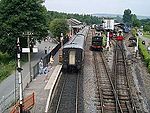Buckfastleigh

Buckfastleigh is a market town and civil parish in Devon, England situated beside the Devon Expressway (A38) at the edge of the Dartmoor National Park. It is part of Teignbridge and, for ecclesiastical purposes, lies within the Totnes Deanery. It is 18 miles (29 km) east-northeast of Plymouth, 20 miles (32 km) southwest of Exeter and has a population of 3,661. It is a centre of tourism and is home to Buckfast Abbey, the South Devon Railway, the Buckfastleigh Butterfly Farm and Otter Sanctuary, the Tomb of Squire Richard Cabell and The Valiant Soldier. With 13 letters, Buckfastleigh is one of the longest place names in England with no repeated letters, tied with Buslingthorpe, Leeds and Buslingthorpe, Lincolnshire, but exceeded by Bricklehampton in Worcestershire with 14 letters.
Excerpt from the Wikipedia article Buckfastleigh (License: CC BY-SA 3.0, Authors, Images).Buckfastleigh
Teignbridge Buckfastleigh
Geographical coordinates (GPS) Address Nearby Places Show on map
Geographical coordinates (GPS)
| Latitude | Longitude |
|---|---|
| N 50.48 ° | E -3.78 ° |
Address
TQ11 0DB Teignbridge, Buckfastleigh
England, United Kingdom
Open on Google Maps











